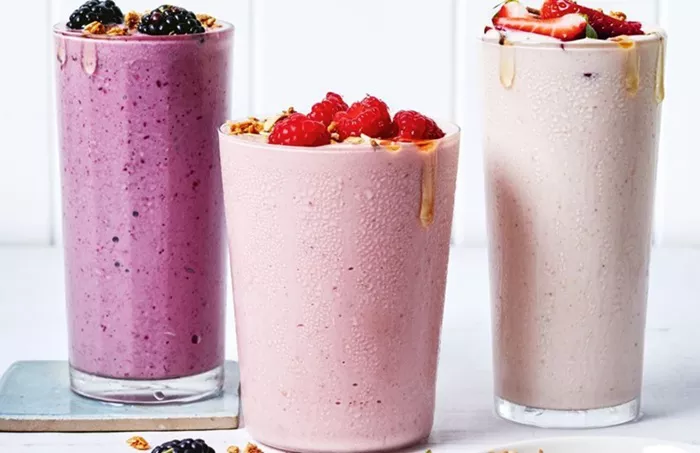Smoothies are often hailed as a healthy, convenient option for a quick snack or meal replacement, but they can also contribute to weight gain if not made with the right ingredients. Experts warn that smoothies with high sugar content, excessive fruit, or added sweeteners can lead to higher calorie consumption, leaving you hungrier sooner and prompting additional snacking.
The Risks of Overindulging in Smoothies
While smoothies are often marketed as nutritious, consuming them without caution can have adverse effects on your health. Many store-bought smoothies, in particular, are packed with fruit juices, syrups, and added sugars that quickly escalate the calorie count. These sugary blends are often less filling than whole foods, which can result in overeating throughout the day.
Bonnie Taub-Dix, a registered dietitian and nutritionist, explains that smoothies can create a fleeting sense of energy due to the sugar rush but ultimately leave you feeling hungry shortly afterward. “Smoothies have evolved into having a health halo even if you put a lot of fruit juice and syrups into them,” Taub-Dix told Prevention. “It can make you feel invigorated for a little bit because of the sugar high, but then you’re left feeling hungry shortly afterward.”
Hidden Sugars and Calories
Adding sweeteners like honey, agave nectar, and maple syrup can improve the flavor of smoothies, particularly if you’re trying to mask the taste of greens. However, nutrition experts caution that these natural substitutes are still high in calories, and when overused, they can contribute to weight gain. Registered dietitian Mary Sabat told Eat This, Not That! that these sugar alternatives are not calorie-free and should be used sparingly.
Protein powders, another common smoothie addition, can be a healthy choice, but it’s important to read labels carefully. Some powders contain added sugars and carbohydrates that might undermine your health goals, according to dietitian Jordan Spivak of Johns Hopkins Medicine.
A Balanced Approach to Smoothie Making
To make a truly healthy smoothie, nutritionists suggest focusing on a balanced mix of ingredients. Lorraine Fye, a dietitian at the Mayo Clinic, recommends including a combination of good carbohydrates, proteins, and healthy fats. When substituting a smoothie for a meal, Fye advises ensuring that it contains enough calories to be satiating but not so many that it becomes counterproductive.
Stanford Health clinical dietitian Leah Groppo offers a simple guideline: to aid in weight loss, keep snack smoothies under 150 calories and meal-replacement smoothies under 350 calories. She also recommends opting for smaller smoothie portions—aim for 8 ounces—and storing any leftovers for later consumption.
If your smoothie is thick enough, Groppo suggests eating it with a spoon instead of drinking it through a straw. The act of chewing helps stimulate hormones that promote feelings of fullness, which can prevent overeating.
How to Make a Healthy, Filling Smoothie
To maximize the nutritional benefits of your smoothie while keeping it low in calories, consider these tips:
- Choose a low-calorie liquid base: Water, oat milk, or coconut milk are excellent options. Water hydrates the body and helps transport nutrients, while both oat and coconut milk are nutrient-rich and lactose-free.
- Pick low-sugar fruits: Opt for fruits like watermelon, raspberries, and blueberries, which are lower in sugar compared to tropical varieties. Freezing your fruit can also make smoothies thicker and more filling, and can help chill the drink.
- Incorporate protein: Protein helps build and repair muscles and curbs hunger. Greek yogurt, chia seeds, and plant-based protein powders (from peas, rice, or hemp) are great protein options.
- Add fiber: Fiber promotes gut health and provides a feeling of fullness. Use whole fruits with pulp, as well as nuts, seeds, and vegetables to boost fiber content.
- Include green ingredients: Vegetables like kale, spinach, and chard are rich in essential nutrients but often go under-consumed. Adding them to your smoothie is an easy way to increase your vegetable intake.
Recipe: Berry Green Smoothie
Looking for a nutritious smoothie recipe? Try this Berry Green Smoothie from Johns Hopkins Medicine:
Ingredients:
- 1 cup of frozen mixed berries
- A generous handful of spinach (fresh or frozen)
- 1 scoop of vanilla protein powder
- 1/2 cup of vanilla Greek yogurt (or vanilla coconut yogurt as a dairy alternative)
- 1 cup of base liquid (water or milk/milk alternatives such as almond or cashew milk)
- 1 tablespoon of ground flaxseed
- A few ice cubes
Nutrition Facts (per serving):
- Calories: 303
- Carbs: 35.8 grams
- Protein: 30.4 grams
- Fat: 6.8 grams
Keep in mind that the nutritional content can vary depending on the specific ingredients and brands you use.
Conclusion
Smoothies can indeed be a healthy and convenient way to nourish your body, but the key is balance. By carefully selecting ingredients, focusing on fiber and protein, and avoiding excess sugars and calories, smoothies can become a nutritious part of your diet without the risk of weight gain.
Related Topics
Watermelon Wonders: The Key to Deep Hydration for Your Skin


































